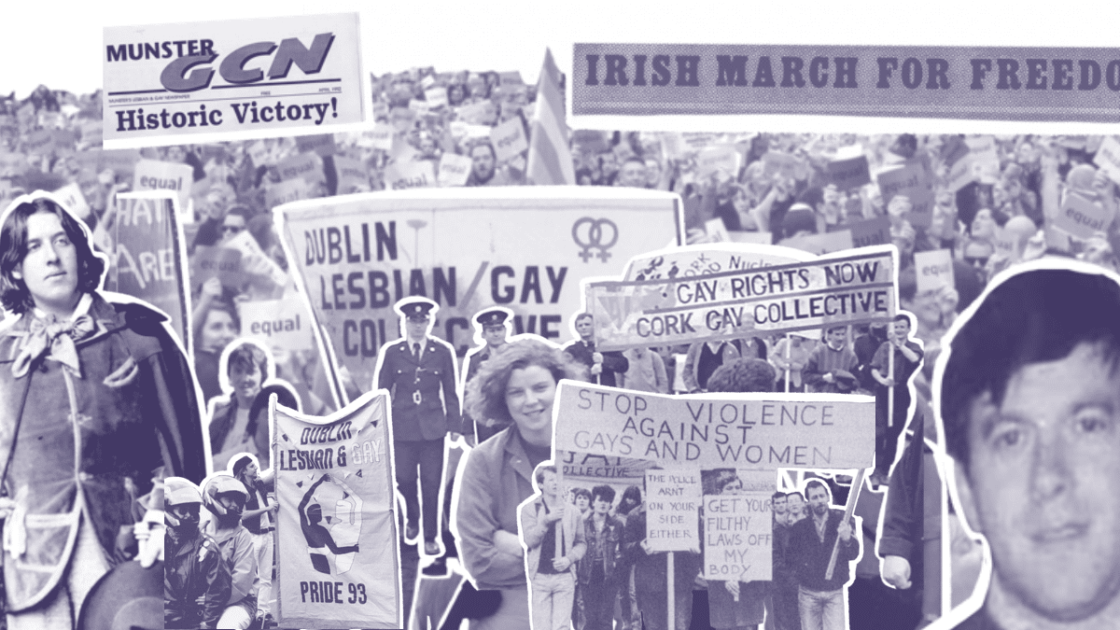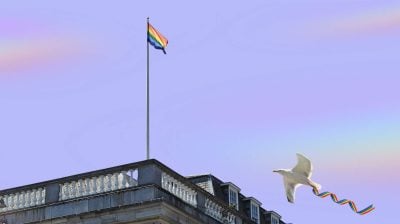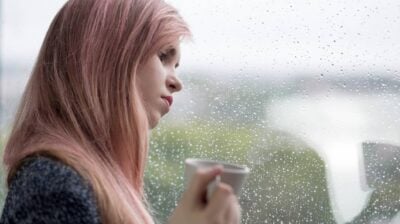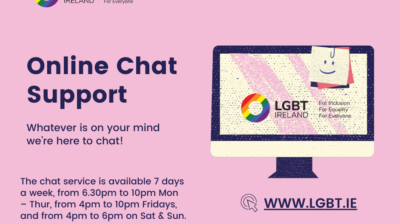A History of Pride in Ireland
Learn more about the history of Pride in Ireland and the Gay Rights Movement.

The celebration of Pride can mean different things to different people. Pride is a celebration and time of remembrance for LGBTI+ people and for some, this means attending Pride parades or events that usually take place in June or July. For others, Pride is a time of protest, and a time to draw attention to the violence and inequality that LGBTI+ people face.
You can choose to celebrate Pride in whatever way feels right for you. From spending time with friends and family, attending protests or direct actions or going to parties and events. Whether you are celebrating (or not celebrating), Pride is unique to each individual.
History of Pride in Ireland
In Ireland, the 1861 Offences Against the Person Act and the 1885 Criminal Law Amendment Act criminalised sexual activity between men, regardless of whether it was consensual or not until 1993. Sexual activity between women was not legally outlawed but was also completely unacceptable across society, religion and politics. It would take a long legal battle, taken by David Norris to the European Court of Human Rights and the activism of many LGBTI+ individuals throughout Ireland, before sexual activity between men was decriminalised in June 1993.
Throughout history, LGBTI+ people faced discrimination because their gender or sexual identity was different from that of straight and cis people. The legislative rights and freedoms that LGBTI+ people in Ireland have now are due to the tireless activism, resistance, organising and suffering that the past generation faced. Although in many ways LGBTI+ people now have many of the same rights that straight and cis people do, there are still laws in Ireland that discriminate against LGBTI+ people and LGBTI+ people continue to face homophobia, biphobia, transphobia and other bigotry in various ways.
Before the term ‘Pride’ became more popular in the 1980s, or parades were organised, events to mark Pride did take place in Dublin to commemorate the 1969 Stonewall Riots and to raise awareness of the oppression faced by LGBTI+ individuals in Ireland. While it would not be until June 1983 before the first Gay Pride Protest march took place, Pride was celebrated in Dublin in many different ways from as early as June 1974.
The 1st Gay Pride Demonstration (1974)
On June 27, 1974, the Sexual Liberation Movement, a Dublin-based organisation that was founded in Trinity College Dublin in 1973, organised the first Gay Pride demonstration in Dublin. The demonstration saw 12 individuals from organisations in the Republic of Ireland and Northern Ireland picket outside the British Embassy and the Department of Justice on St. Stephen’s Green to highlight the injustices of the 1861 and 1885 laws that criminalised sexual activity between males. Amongst the 12 brave individuals who protested that day were David Norris, Jeffrey Dudgeon, Hugo MacManus, Michael Kerrigan, Margaret McWilliam, Joseph Leckey and Edwin Henshaw.
Under the 1861 Offences Against the Person Act, gay sex was a criminal offence and was treated the same as having sex with animals. The law stated: “Whosoever shall be convicted of the abominable crime of buggery, committed either with mankind or with any animal, shall be liable to be kept in penal servitude for life.” Those who picketed outside the British Embassy and the Department of Justice carried placards that stated: ‘Homosexuals are Revolting’, ‘Gay is Good’ and ‘Lesbian Love’.
In a sign of the growing international gay rights movement and the solidarity amongst those organisations, a decision had been taken in May 1974 at the annual congress of the Campaign for Homosexual Equality, to dedicate Gay Pride day 1974 to highlight the situation faced by homosexuals in Ireland and to offer their support to them. As a result, on the same day that the British Embassy and the Department of Justice were picketed, activists in Norway similarly picketed the British Embassy in Oslo carrying placards that stated: ‘Stop the Oppression of Irish Homosexuals’ and ‘No to discrimination on the grounds of being different’. An image of those protesting in Dublin was printed in the Irish Times.
David Norris’ High Court challenge (1977)
David Norris (now Senator Norris) took a High Court challenge against the laws which criminalised sexual activity between men in Ireland. In 1980, Norris’ case was defeated in the High Court. Afterwards, it was appealed to the Supreme Court and also defeated.
Opening of Hirschfeld Centre (1979)
On St. Patrick’s Day 1979, the Hirschfeld Centre, located at 10 Fownes Street, Temple Bar, opened its doors, going on to become a home from home for many LGBTI+ individuals in Ireland. In many ways, the Hirschfeld Centre became a lifeline for Ireland’s LGBTI+ community during a time when few other venues existed that welcomed members of the LGBTI+ community. Named after Magnus Hirschfeld, a pioneering sexologist who championed gay rights in Germany in the early 20th century, the Hirschfeld Centre was the headquarters for the National Gay Federation (NGF) and Liberation for Irish Lesbians (LIL), Ireland’s first lesbian organisation established in 1978. The Hirschfeld Centre also housed a disco (Flikkers), a cinema called the Hirschfeld Biograph, a telephone befriending service Tel-A-Friend, which would become Gay Switchboard, the secretariat of the International Gay Association, a support service for parents of homosexuals called Parents Enquiry and a café.
1st Gay Pride Week (June 1979)
Ireland’s first proper Gay Pride Week was held from June 25th to July 1st in 1979 and was organised by the National Gay and Lesbian Federation. The 10-day event commemorated the 1969 Stonewall Riots and drew attention to the difficulty and oppression that members of the LGBTI+ community in Ireland faced.
Over the course of the week, events organised included a political forum with TDs, which included Michael Keating (Fine Gael), Niall Andrews (Fianna Fail), Ruairi Quinn (Labour Party) and Noel Browne (Independent). Dr Browne, in particular, was a steadfast supporter of the Gay Rights Movement in Ireland. Other events included a fancy dress ball at Flikkers, a Women’s Night, and an Open Night at the Hirschfeld Centre. The NGF and LIL also invited individuals to wear gay pride badges or symbols such as the pink triangle or pink carnations, the then symbols of gay pride.
The 1979 Gay Pride Week also marked the beginning of a number of traditions that would become cornerstone events for Dublin’s Gay Pride Week events between 1979 and 1983. Firstly, there was leafleting on the streets of Dublin, where a small group of LGBTI+ individuals took to the streets handing out leaflets to members of the public as part of their efforts to generate greater awareness and understanding of the Gay Rights movement and homosexuality. Secondly, the NGF and LIL hosted a picnic in one of Dublin’s main parks. In 1979 the picnic took place in Phoenix Park while in later years it took place in Merrion Square.
Finally, a highlight of the week and perhaps one of the most daring events organised was what was referred to as the ‘Pub Zap’. This involved LGBTI+ individuals wearing gay pride badges and going around to the pubs in Dublin to see how many they would get thrown out of. During the 1982 Gay Pride Week’s Pub Zap, fifteen individuals took part. In the end, they revealed that of the 8 pubs they had gone to, they were refused service in 5. Between 1979 and 1982 these events provided Dublin’s and the wider Irish LGBTI+ community with an opportunity to mark Gay Pride and to shine a light on the situation facing LGBTI+ individuals. Throughout those years, many Irish newspapers reported on the events organised, helping to generate awareness of Gay Pride in Ireland.
AIDS Activism in Ireland (1980s)
In 1982 the first AIDS case was diagnosed in Ireland. The initial outbreak of the epidemic was met with mass hysteria and the publishing of damaging information about those believed to be most at risk. Among these groups were the gay community, haemophiliacs (a blood disease that causes the blood not to clot) and sex workers. Reporting in the media led to a misunderstanding about AIDs in Ireland and generated stigma towards groups identified as at risk. Prompted by this media scaremongering, various gay organisations and groups within Ireland came together to form Gay Health Action (GHA) at a meeting in Trinity College in 1985.
It was left to Ireland’s LGBTI+ community to provide the first active national response, focusing on AIDS education as a key concern. It was not until 1987, that the Health Education Bureau launched its Casual Sex Spreads AIDS campaign on television and in the press. This Irish campaign inspired fear. It did not contain any message about modes of prevention such as contraception but rather promoted monogamy and celibacy as the solution. Within the first years of the AIDS crisis in Ireland, it was the LGBTI+ community and its alternative network of communication that countered and confronted the epidemic.
The 1st National Gay Conference, Cork (1981)
The first National Gay Conference was held between the 15th and 17th of May 1981 at Connolly Hall, the headquarters of the trade union movement in Cork. The conference was an attempt to advance gay rights in Ireland on an all-island basis and to recognise that organisations existed outside Dublin and that they should have greater input into the gay rights movement in Ireland. It was an attempt to take stock of where the Irish gay rights movement had come from since the 1970s, to look to the future, but also to explore why, in the view of the organisers, the movement was not stronger and unified.
The Conference provided a rare opportunity for those who were often marginalised within the male-dominated and Dublin-centric gay rights movement in Ireland to have their voices heard. For example, John Porter, a founding member of the Galway Gay Collective used it as an opportunity to explain the challenges of organising in a county like Galway due to the lack of facilities and low numbers getting involved. While Joni Sheerin, Liberation for Irish Lesbians, expressed her hope that the conference would foster ‘a new solidarity between gay women and men.’
In June 1981 the Cork Irish Gay Rights Movement (IGRM) and the Cork Gay Collective organised the first gay pride events in Cork. The 1981 Munster gay pride included leafleting on the streets of Cork and Waterford and sponsored advertising campaigns on local radio in both counties for the Munster Gay Switchboard. A giant pink triangle was also erected by members of the Cork and Waterford IGRM at the top of the Comeragh Mountains to ‘symbolise the unity of gay people in Munster in our fight for civil rights.’
The 1st Large Scale LGBTI+ March (1983)
In March 1983, the first large-scale LGBTI+ protest march took place in Dublin. The march was organised in response to the murder of Declan Flynn in a homophobic attack, in Fairview Park. Five people, aged between 12 and 18 and charged with the murder of a gay man, Declan Flynn, were arrested after admitting they were “clearing the park of queers.” Around 400 people marched from Liberty Hall to Fairview Park to express their outrage and desire for justice. The march was a demand for change and marks a turning point for recognising the injustices against LGBTI+ people. The tragic murder of Declan Flynn did play a major role in galvanising the LGBTI+ movement in Ireland.
1st Gay Protest March (1983)
Later that year, on June 25th, 1983, the National Gay Federation, Liberation for Irish Lesbians and the Dublin Gay Collective organised the first Gay Pride Protest March in Ireland. Noel Walsh, then a member of the NGF’s parade steering committee, speaking in 1983 explained that the protest march was being organised to ‘celebrate this pride in our identity, but also to protest at the lack of humanity and equality shown to lesbians and gay men.’ Between 150 – 200 people walked from Stephen’s Green to the GPO on O’Connell Street. Further Gay Pride protest marches would take place in 1984 and 1985. It would not be until 1992 that another Gay Pride march would take place in Dublin. From the mid-1980s onwards the priority for activists was responding to the emerging AIDS crisis in Ireland.
Protests continue (1987)
In 1987, the Hirschfield Centre was destroyed by a fire, which many believe was an intentional hate crime.
In 1988, lacking the resources for a march, activists hosted a kiss-in outside Leinster House. In one of the most blatant public acts carried out by gay and lesbian individuals over 30 gay/lesbian activists staged a kiss-in outside Leinster House in 1988, making headlines as far away as Tipperary. For the gay males who took part, this was particularly brave considering the laws still existed that criminalised such activity, whether in private or public. In an editorial in the Nationalist, condemning the action, the editor argued that it “should alert the public at large to the brazen nature of the assault which is being mounted on traditional and fundamental Christian values. […] Is it not time for society, if not for God’s sake then for its own preservation to say that the kissing has to stop?” Also that year, LGBTI+ activists picketed the Vatican embassy on Navan Road in Dublin, decorating the railings outside with condoms.
Senator Norris’ European High Court Challenge (1988)
In 1988 the European Court of Human Rights, following Norris’ decision to take a case to it challenging the 1861 and 1885 laws which had been ruled to be constitutional by the Irish Supreme Court in 1983, ruled that the laws did in fact contravene the European Convention on Human Rights. Norris had successfully argued that the laws were in violation of Article 8 of the Convention.
His case against the Irish State over the constitutional status of the criminalisation of certain homosexual acts was won. The ECHR case allowed for future changes to the decriminalisation of homosexuality in Ireland.
In 1988, GLEN (The Gay and Lesbian Equality Network) was also founded, the first issue of GCN was published, and there was an increase of new literature critiquing existing laws and arguing why LGBTI+ equality and justice were important.
Prohibition of Incitement Act 1989
In 1989 the Prohibition of Incitement to Hatred Act was passed in Ireland and it included hatred on the bases of sexual orientation. Sexual orientation was only included in the Act after considerable lobbying by LGBTI+ activists
Decriminalisation of sexual activity between men (1993)
In June 1993, Dáil Éireann passed legislation to decriminalise sexual activity between men in Ireland. Although Ireland still had a long way to go for full equality, this marked a huge step forward for LGBTI+ rights.
The Unfair Dismissals Act 1977 was also amended in 1993 to include sexual orientation which was another important moment for the gay rights movement which had been lobbying the government to include this for many years.
The Employment Equality Act (1998)
In 1998, the Employment Equality Act was introduced, prohibiting discrimination in employment based on several grounds, including sexual orientation.
Fight for recognition of gay marriage (2003)
Marriage equality advocates Senator Katherine Zappone and Dr Ann Louise Gilligan began the fight to have their Canadian marriage recognised in Ireland.
Lesbian couple refused the right to marry (2006)
A judge finds that the right to marry in Ireland is confined under the Constitution to the union of a man and woman. The court ruled that the refusal to permit same-sex couples to marry in Ireland does not breach provisions of the European Convention on Human Rights.
The Civil Partnership Act (2010)
The Civil Partnership Act was passed in Ireland in 2010, which marked a stepping stone to same-sex marriage. The act set out rights that civil partners have towards each other, which were similar to that of married couples. However, the act did not change the law on issues relating to children, e.g. guardianship or adoption.
First openly LGBT TDs elected to the Dáil (2011)
Another milestone came at the end of the 2011 General Election with three openly gay TDs being elected. Jerry Buttimer, John Lyons and Dominic Hannigan took their seats in the Dáil representing Cork South-Central, Dublin North-West and Meath East.
Ireland Legalises Same-Sex Marriage (2015)
After years of campaigning, on May 22nd, 2015, Ireland officially passed the same-sex marriage referendum, becoming the first country to legalise gay marriage by popular vote (62% of votes in favour vs 38% against). Thousands of people gathered in Dublin Castle to celebrate the results, which marked a historical day for Ireland. Celebrations are still held annually to mark the success of the referendum.
Dr Lydia Foy & The Gender Recognition Act (2015)
Dr Lydia Foy has lived publicly as a woman since 1991. In March 1993, Dr Foy applied to the office of the Registrar General for a new birth certificate to reflect her gender. She was refused. In April 1997, after a number of years’ unsuccessful correspondence with the Registrar General’s office, Dr Foy initiated High Court proceedings to compel the Registrar to issue her with a new birth certificate. Her case was rejected multiple times until she began new proceedings in the High Court, seeking a declaration under the ECHR Act that Irish legislation was incompatible with the European Convention regarding the registration and issue of birth certificates. In May 2010, the Government set up the Gender Recognition Advisory Group, the Advisory Group published its recommendations for proposed gender recognition legislation to the Minister for Social Protection in 2011. In 2014, the Minister published the (Revised) Scheme for the Gender Recognition Bill 2014 and in December 2014 the Gender Recognition Bill 2014 was published. The Gender Recognition Act was passed on July 15th 2015. Dr Foy became the first person to be legally recognised by this Act. Her ongoing fights with the courts to have her gender legally recognised were instrumental in the conceiving of this legislation for transgender people in Ireland.
Northern Ireland Legalises Same-Sex Marriage (2020)
On January 13th 2020, same-sex marriage was legalised in Northern Ireland. This meant that same-sex couples could now legally marry in Northern Ireland and that couples who got married elsewhere would have their marriage recognised by the state.
- Some of the research in this article was taken from Gay and Lesbian Activism in the Republic of Ireland, 1973-93
- Visit the Irish Queer Archive for more information on Irish LGTBI+ history
Need more information?
Would you like more information? Maybe you would like to talk through your own situation? Get in touch through our online chat system for 16 to 25 year olds – Monday to Friday 4pm to 8pm.
- Chat now to a trained Youth Information Officer
- Or leave us a message and we will email you back






